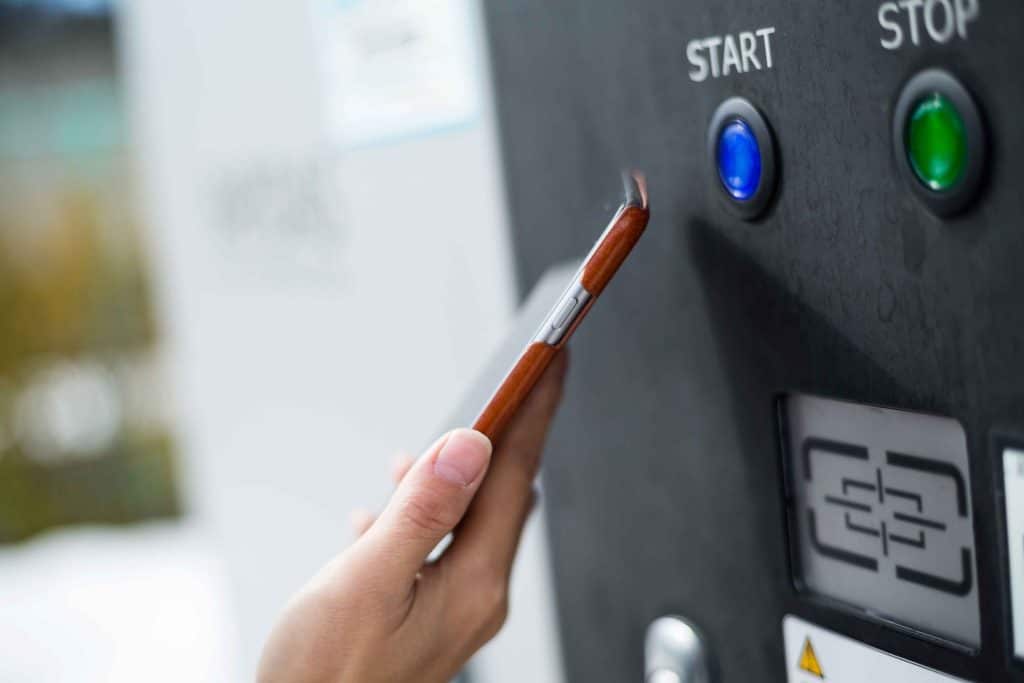Introduction
The evolution of vending machines from simple mechanical devices to sophisticated digital platforms marks a significant leap in retail technology. Today’s digital vending machines, powered by smart vending software and integrated with mobile vending apps, have transformed the landscape of on-the-go retail.
This blog explores the journey from the initial concept of vending machines to the advanced digital vending solutions we see today, highlighting their development, technological advancements, and the impact they have on the market.
Get Free Consultation
Key Takeaways
- Digital vending machines offer enhanced customer experiences through touchscreen interfaces and mobile app integration.
- Smart vending software and IoT technology enable real-time inventory management and data analytics.
- The introduction of touchless vending machines addresses current health and safety concerns.
- Digital vending solutions extend beyond snacks and beverages, encompassing retail and specialized products.
- The shift towards digital vending reflects broader trends in automation, convenience, and personalized retail.
Evolution of Vending Technology
From Mechanical to Digital
The journey of vending machines from their mechanical origins to the sophisticated digital models we encounter today is a fascinating narrative of innovation and adaptation. Initially, vending machines were purely mechanical devices, relying on simple mechanisms to dispense products upon the insertion of a coin. These early models were limited in functionality and variety, typically offering only a small selection of items.
However, the advent of electronic technology marked the first significant leap forward, introducing machines capable of more complex transactions and offering a wider range of products. The real transformation, though, began with the integration of digital technologies. Microprocessors and touch screens replaced mechanical buttons and levers, dramatically enhancing the user interface and experience. The introduction of internet connectivity allowed these machines to communicate with operators in real-time, reporting sales data, stock levels, and operational status.
This evolution from mechanical simplicity to digital complexity reflects broader technological advancements and has been instrumental in expanding the capabilities and reach of vending machines in the retail landscape.
Read more about our Smart Vending Solutions!
The Role of Software in Vending Evolution
The evolution of vending machines into the intelligent, connected devices we see today has been largely driven by the development of smart vending software. This software has revolutionized how vending machines operate, turning them into dynamic retail points capable of much more than simple transactions.
With smart vending software, machines can now manage inventory in real-time, adapt product offerings based on consumer preferences, and even engage customers through interactive displays and personalized recommendations. Moreover, the integration of payment processing software has enabled the acceptance of various payment methods beyond cash, including credit cards, mobile payments, and even cryptocurrencies.
This technological leap has not only improved operational efficiency for vending machine operators but also significantly enhanced the consumer experience, making vending machines a preferred choice for on-the-go purchases. The software’s ability to analyze data and generate insights has opened up new opportunities for targeted marketing and sales optimization, marking a new era in the vending industry.

Impact on Retail and Consumer Behavior
The advent of digital vending machines has had a profound impact on the retail sector and consumer behavior, signaling a shift towards more autonomous, convenient, and personalized shopping experiences. By offering products 24/7 without the need for staffing, digital vending machines have introduced a new level of convenience that aligns with the increasingly busy and mobile lifestyles of modern consumers.
This has led to an expansion of the vending market, with machines now found in more diverse locations and offering a wider range of products, from electronics and cosmetics to gourmet food and beverages. The ability to tailor product selections to the specific tastes and preferences of different consumer demographics has also allowed vending machine operators to tap into niche markets and meet consumer demands more precisely.
Furthermore, the seamless interaction and instant gratification provided by digital vending machines have raised consumer expectations, influencing retail strategies across the board. Retailers are now more focused on incorporating technology and personalization into their offerings to meet the standards set by digital vending. The result is a more dynamic and consumer-centric retail environment, where convenience, efficiency, and customization are paramount.
Table: Milestones in Vending Machine Technology
| Year | Milestone | Impact |
| 1980s | Introduction of Electronic Vending | Enhanced reliability and security |
| 2000s | Integration of Touch Screens | Improved user experience |
| 2010s | Adoption of IoT and Smart Software | Enabled remote management and data analytics |
Enhancing Customer Experience
Personalization and Convenience
Digital vending machines are revolutionizing the vending experience by leveraging customer data and preferences to provide a highly personalized service. Through the use of sophisticated algorithms and smart vending software, these machines analyze purchase histories and customer interactions to offer personalized product recommendations.
This tailored approach not only enhances the consumer experience but also increases the likelihood of purchase by aligning offerings closely with individual preferences. Additionally, digital vending machines streamline transactions by remembering customer favorites and payment details, making the purchase process quicker and more convenient.
This level of personalization and convenience exemplifies how digital vending machines are catering to the evolving needs and expectations of modern consumers, creating a more engaging and satisfying vending experience.
Integration with Mobile Apps
Connecting vending machines with mobile apps offers a multitude of benefits that extend the functionality and convenience of traditional vending services. Through mobile apps, customers can interact with vending machines remotely, allowing for pre-ordering, contactless payments, and even customization of products before pickup.
This integration facilitates a seamless transaction process, reducing wait times and enhancing the overall user experience. Furthermore, mobile apps can serve as platforms for loyalty programs, rewarding regular customers with discounts, free products, or other incentives, thereby fostering customer loyalty and encouraging repeat business.
The connectivity between vending machines and mobile apps opens up new avenues for customer engagement and service innovation, making vending an integral part of the digital retail landscape.

Touchless Interactions
In response to growing health and safety concerns, touchless technology has become increasingly important in vending. Digital vending machines equipped with touchless technology, such as gesture control, QR code scanning, or NFC payments, allow consumers to make selections and complete transactions without physical contact with the machine.
This adaptation not only addresses hygiene concerns but also aligns with changing consumer expectations for safer and more convenient retail interactions. The incorporation of touchless technology into vending machines demonstrates the industry’s commitment to innovating and adapting to meet contemporary challenges, ensuring that vending remains a convenient and safe option for consumers.
Smart Inventory and Operations Management
Real-time Inventory Tracking
Digital vending machines utilize IoT sensors and smart software to achieve real-time inventory monitoring, a critical feature for maintaining optimal stock levels and reducing waste. These advanced systems provide instant visibility into inventory status, alerting operators to low stock or potential shortages before they impact sales.
By continuously tracking inventory, digital vending machines can minimize stockouts, ensuring that popular products are always available, and reduce excess inventory, preventing waste and loss from expired products. This level of inventory control not only improves operational efficiency but also enhances the customer experience by reliably meeting demand.
Predictive Analytics for Restocking
The integration of data analytics and machine learning into digital vending operations transforms inventory management with predictive capabilities. By analyzing historical sales data, consumer trends, and external factors, predictive analytics can forecast future product demand with remarkable accuracy.
This foresight enables operators to optimize restocking schedules and inventory levels, ensuring that machines are stocked efficiently to meet anticipated demand without overstocking. The application of predictive analytics in restocking processes results in a more responsive, efficient vending operation that can adapt to consumer needs and market dynamics, maximizing sales opportunities while minimizing waste.
Efficiency and Sustainability
Digital innovations in vending machines are making significant contributions to both operational efficiency and environmental sustainability. Enhanced efficiency is achieved through streamlined operations, reduced energy consumption, and minimized product waste, thanks to smart inventory management and predictive analytics.
Additionally, digital vending machines often incorporate energy-saving features and support eco-friendly practices, such as recycling programs and the promotion of products with sustainable packaging. By reducing waste and lowering energy use, digital vending machines exemplify how technological advancements can lead to more sustainable business practices, aligning with broader environmental objectives and consumer expectations for greener retail options.
Expanding the Vending Market
Beyond Snacks and Drinks
The landscape of digital vending machines is expanding far beyond the traditional offerings of snacks and drinks. Today, these advanced machines serve as automated retail points for a wide array of products, including electronics like headphones and chargers, beauty and cosmetics for on-the-go convenience, and even essential goods such as masks and hand sanitizers.
This diversification not only broadens the market potential for vending operations but also meets the increasing consumer demand for instant access to a wider variety of products. The ability of digital vending machines to stock and sell such a diverse range of items illustrates their flexibility and potential to revolutionize retail in various settings, from airports and malls to offices and public spaces.
Diversified Product Offerings in Digital Vending Machines:
| Product Category | Examples |
| Electronics | Headphones, chargers, portable batteries |
| Beauty and Cosmetics | Hand creams, lip balms, travel-sized cosmetics |
| Essential Goods | Masks, hand sanitizers, first aid kits |
| Specialty Items | Apparel, books, small gadgets |
Retail Vending Innovations
Digital vending machines are emerging as a novel channel for brands to reach consumers directly, offering a unique blend of convenience, product sampling, and exclusive access to limited editions. Brands across sectors, from beauty to technology, are leveraging these machines to introduce consumers to new products in an engaging, interactive manner.
Retail vending innovations enable brands to capture the attention of potential customers in high-traffic areas, providing them with a memorable brand experience that goes beyond traditional retail environments. This approach not only drives sales but also enhances brand visibility and customer engagement in an increasingly competitive market.
Specialized Vending Solutions
The advent of specialized digital vending machines has opened new avenues for tailored services across various industries. These machines are designed to meet specific needs, such as dispensing prescription medications in healthcare settings, offering library books for public borrowing, or providing tool rentals in construction and DIY projects.
The customization and convenience offered by these specialized solutions demonstrate the versatility of digital vending technology and its capacity to transform service delivery in numerous sectors. By catering to niche markets and specific consumer needs, specialized vending machines enhance accessibility and efficiency, setting a new standard for automated services.
The Future of Digital Vending
Integration of Advanced Technologies
The future of digital vending machines is closely tied to the integration of cutting-edge technologies like AI, AR/VR, and blockchain. AI and machine learning algorithms can offer personalized product recommendations based on user history, while AR/VR technology provides immersive experiences that can showcase products in a virtual environment before purchase.
Blockchain technology, on the other hand, promises enhanced transaction security and transparency, building trust between consumers and vending operations. These technological advancements are set to further personalize the vending experience, streamline operations, and secure transactions, pushing the boundaries of what’s possible in automated retail.

The Role of Digital Vending in Smart Cities
Digital vending machines are poised to play a significant role in the development of smart cities, offering public convenience and creating economic opportunities. Integrated within a city’s IoT ecosystem, these machines can provide essential goods and services to residents and visitors, enhancing urban living and accessibility.
Moreover, the data collected by digital vending machines can contribute valuable insights into consumer behavior and urban dynamics, aiding city planners and businesses in making informed decisions. By fitting seamlessly into the smart city infrastructure, digital vending machines contribute to the creation of connected, efficient, and responsive urban environments.
Contributions of Digital Vending Machines to Smart City Ecosystems:
| Contribution | Description |
| Public Convenience | Access to goods and services 24/7 in accessible locations. |
| Economic Opportunities | New retail channels and job creation in machine maintenance and restocking. |
| Data Insights | Consumer behavior data contributing to urban planning and market research. |
Challenges and Opportunities
The expansion of digital vending faces several challenges, including regulatory hurdles that vary by region and potential market saturation. Navigating these obstacles requires innovation and adaptability from vending machine operators and manufacturers. However, these challenges also present opportunities for growth and innovation.
The continuous development of technology, changing consumer behaviors, and the untapped potential in various markets offer fertile ground for the evolution of digital vending. By embracing innovation, focusing on sustainability, and enhancing user experience, the digital vending sector can overcome these challenges and continue to thrive in the changing retail landscape.
Conclusion
The transformation of vending machines from coin-operated mechanical units to sophisticated digital platforms signifies a remarkable evolution in retail technology. Digital vending machines, equipped with smart software, touch screens, and mobile app connectivity, have not only enhanced the vending experience for consumers but also opened new avenues for inventory management, market expansion, and personalized retail. As technology continues to advance, the potential for further innovation in the vending industry promises to redefine convenience and accessibility in retail.
Vending Solutions
With our smart vending solutions, grab-and-go shopping gets simpler, faster, and more personalized.
Frequently Asked Questions (FAQs):
How do digital vending machines improve the customer experience?
Digital vending machines enhance the customer experience by offering personalized options and seamless transactions, utilizing touch screens and mobile connectivity for convenience and speed.
What advantages does smart inventory management offer to vending operators?
Smart inventory management provides real-time tracking and predictive analytics, reducing waste and ensuring machines are stocked efficiently to meet consumer demand.
Can digital vending machines truly offer a wider variety of products?
Yes, digital vending machines can dispense a diverse range of products beyond traditional snacks and drinks, including electronics, cosmetics, and even pharmaceuticals, thanks to advanced inventory systems.
How might future technologies further enhance digital vending machines?
Future technologies like AI, AR/VR, and blockchain could offer even more personalized experiences, immersive interactions, and secure transactions in digital vending machines.
What role do digital vending machines play in the concept of smart cities?
In smart cities, digital vending machines contribute to public convenience and economic opportunities, providing accessible services and integrating with city-wide data networks for insights.

